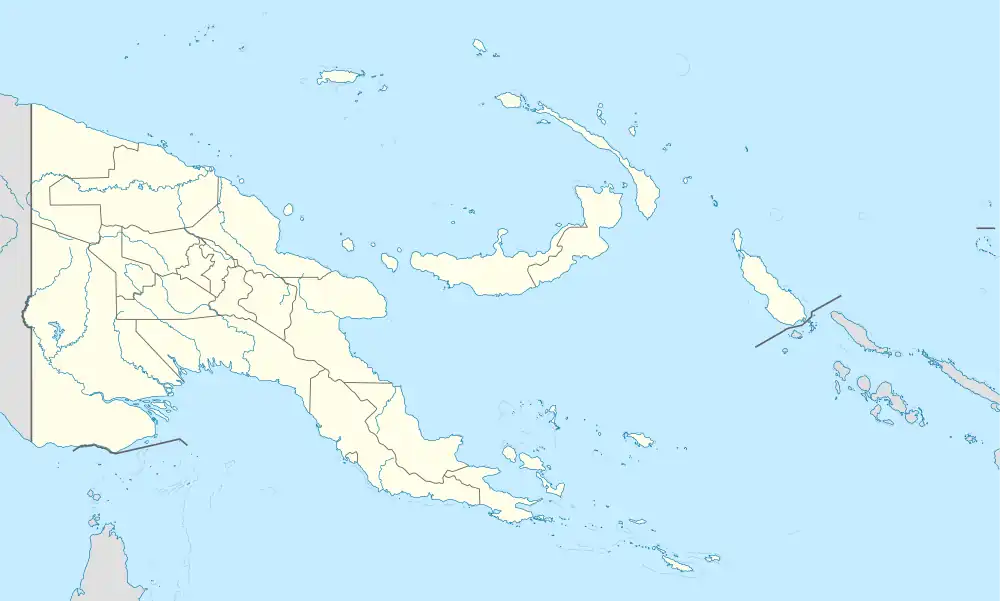Nickname: Moresby Island | |
|---|---|
 Louisiade Archipelago, Basilaki on the top left. | |
 Basilaki Island Location within Papua New Guinea | |
| Geography | |
| Location | Oceania |
| Coordinates | 10°37′19″S 151°00′55″E / 10.62194°S 151.01528°E[1] |
| Archipelago | Louisiade Archipelago |
| Adjacent to | Solomon Sea |
| Total islands | 1 |
| Major islands |
|
| Area | 106 km2 (41 sq mi) |
| Length | 17 km (10.6 mi) |
| Width | 10 km (6 mi) |
| Coastline | 87.6 km (54.43 mi) |
| Highest elevation | 531 m (1742 ft) |
| Highest point | Mount Kova Sina |
| Administration | |
| Province | |
| Island Group | Samarai Islands |
| Island Group | Basilaki Islands |
| Ward | Split |
| Largest settlement | Yokowa (pop. 300) |
| Demographics | |
| Population | 1883 (2014) |
| Pop. density | 18/km2 (47/sq mi) |
| Ethnic groups | Papauans, Austronesians, Melanesians. |
| Additional information | |
| Time zone | |
| ISO code | PG-MBA |
| Official website | www |
Basilaki Island (Moresby Island[2]) is an island in the Louisiade Archipelago in Milne Bay Province, Papua New Guinea. It is located at the eastern end of the New Guinea mainland.
History
First recorded sighting by Europeans was by the Spanish expedition of Luís Vaez de Torres on 18 July 1606, that charted it as San Buenaventura (after Saint Bonaventure).[3][4][5]
A party of French naturalists was believed to have been murdered in James Bay in October 1880.[6][7]
This island was the scene of the murder of two sailors by natives in Hoopiron Bay, July 28, 1885.[8] The men were Captain John Friar and John Watkins, a carpenter of Lallah Rook, a schooner[9] registered in Saint John, New Brunswick. The vessel anchored in the bay to take on fresh water. After the murders, the crew sailed away.[10]
The murders were revenge taken for two unpaid-for deaths of natives in Friar's employ. Despite a two-day search of the island on October 16, by the crews of Governor Blackall, and HMS Diamond and HMS Raven, the murderers were not found, although the skulls of Friar and the carpenter were recovered and given a burial at sea.[11] Later Diamond returned and burned all the villages nearby. [12]
Three planes were ditched off the island in 1943, a P-38H Lightning, a P-38F Lightning, and a B-24D Liberator "The Leila Belle".[13]
Administration
The island is part of the following Wards:
- Hamama, on the western part.
- Buairi, which is on Buairi island, includes a small portion of the western part.
- Habani, on the south-central area.
- Gigia, on the north-central area. (with Bwanadalu island)
- Bedauna, on the southeast area (with Kitai islands)
- Yokowa, on the northeast area.
All Wards belong to Bwanabwana Rural Local Level Government Area LLG, Samarai-Murua District, which are in Milne Bay Province.[14]
Geography
Basilaki is located on the east of Samarai Islands of the Louisiade Archipelago. The island is part of the Basilaki group. Mount Kova Sina (Fairfax) reaches a height of 531 meters, and is located at the center of the island. Mount Baiaule is 444 meters, and is located at the center of the island. Mount Salawie is 333 meters, and is located at the south of the island.
Demographics
The population of 1883 is living in 37 villages across the island.[15] Yokowa, where the school is located, is the largest village. although, the main dock is at Habani, at the other side of the island. List of villages: Hoopiron Bay, Gaiogaiokawasi, Baiaule, Hilomai, Habani, Halahalawuwu, Salewai, Wetoa, Dauyai, Hiliki, Towina, Kawalolo, Bedauna, Mwahui, Kalotau, Taladio, Agarauna, Huba, Yokowa, Dahidahina, Siu, Pihigole, Gigia, Doba, Tanubuibuina, Delina, Tutuila, Hewoli, Hamama, Duiauna, Nuanuatieu, Gogolabia, Hakalihi, Bogala, Kalamadau, Yahala.
Economy
The islanders, are farmers as opposed to eastern Louisiade Archipelago islanders. they grow Sago, Taro, and Yams for crops.
Transportation
There is a dock at Habani.
References
- ↑ Prostar Sailing Directions 2004 New Guinea Enroute, p. 168
- ↑ Admiralty hydrogr. dept (1879). "Moresby Island". The Australia directory. Vol.2. 2nd-6th ed. [With]. pp. 520–521.
- ↑ Coello, Francisco "Notas sobre los planos de las bahias descubiertas en el año 1606 en las islas de Espiritú Santo y de Nueva Guinea, que dibujo el capitán Don Diego de Prado y Tovar, en igual fecha"" Boletín de Sociedad Geográfica de Madrid, t.IV. 1º semestre 1878, Madrid, p.67
- ↑ Sharp, Andrew The discovery of the Pacific Islands Oxford, 1960, p.66.
- ↑ Brand, Donald D. The Pacific Basin: A History of its Geographical Explorations The American Geographical Society, New York, 1967, p.137.
- ↑ "Further massacres..." The Record-Union. Sacramento, California. 30 Dec 1880. p. 4. Retrieved 21 July 2015 – via Newspapers.com.
- ↑ "Further atrocities in the South Seas". Daily Honolulu Press. 19 Feb 1881. p. 1. Retrieved 21 July 2015 – via Newspapers.com.
- ↑ Resurgo says July 2
- ↑ Resurgo says barque
- ↑ Pincombe, C. Alexander; Larracey, Edward W. (1990). Resurgo : the history of Moncton. Vol. 1. New Brunswick, Can.: City of Moncton. pp. 210–211. ISBN 0969463405.
- ↑ Sir Peter Scratchley (1887). "New Guinea". Australian defences and New Guinea. Macmillan. p. 344.
- ↑ Sir Peter Scratchley (1887). "Sir Peter's Diary". Australian defences and New Guinea. Macmillan. p. 305, fn1.
- ↑ Basilaki Island Pacific Wrecks
- ↑ "LLG map" (PDF). Archived from the original (PDF) on 2010-08-11. Retrieved 2016-03-16.
- ↑ "map". Archived from the original on 2016-03-16. Retrieved 2016-03-16.